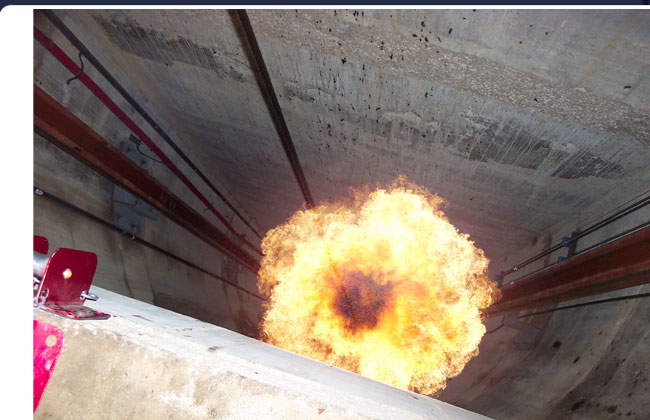




Piezoelectric Fires at Soudan Mine State Park, Minnesota
Underground Fire Threatens $60 Million University Research Lab
by Jenna Ross for the Star Tribune
March 18, 2011
The mysterious blaze, which started Thursday, is slowly burning deep within the Soudan Underground Mine on Minnesota's Iron Range... threatening a $60 million research facility.
Laboratories operated by the University of Minnesota conduct experiments that seek to explain how the universe was formed. It operates the experiments underground to protect them from cosmic rays that shower the Earth.
The fire, which triggered an alarm at 9 p.m. Thursday and persisted through Friday, has puzzled fire officials determined to put it out before it damages the facility 2,341 feet below the surface and two floors below the blaze.
No one has been injured, and buildings above ground are safe.
The fire poses two threats, said Carson Berglund, spokesman for the Minnesota Interagency Fire Center. It is burning timbers that line the mine shaft, and it has forced officials to shut off electric power -- and in turn, the pumps that dispel groundwater. That water is now rising.
With time, those two threats would cancel each other out. But "in between, there's $60 million worth of equipment," Berglund said.
The mine is the key feature of the Soudan Underground Mine State Park, which attracted 36,707 visitors in 2010, according to the state Department of Natural Resources, which helps operate the lab. Families and school groups don hard hats for a dark, 3-minute elevator ride that brings them a half-mile underground and shows them the area's mining past.
Firefighters rode that elevator late Thursday night to estimate the damage and fight the fire with water. But they "didn't dare stay down there for very long," Berglund said.
Judging from that trip and now-broken security cameras, "property damage inside the mine is anticipated to be extensive," according to a DNR press release.
An "incident management team," with help from the Department of Homeland Security and experts in the mining industry, is "brainstorming" how to proceed, Berglund said.
Marvin Marshak, a U physics professor who founded the laboratory in 1979, has been calling experts nationwide, relaying their opinions about the best way to fight the fire.
He has learned that of the three elements to any fire -- heat, oxygen and materials to burn -- "the only way this can really be addressed is by cutting off the ventilation."
The lab is bigger than one might expect, built through two excavations of more than 100,000 tons of rock. It houses two major multi-year experiments: One explores dark matter and the other studies neutrinos, subatomic particles that scientists believe hold the key to understanding universal laws of physics.
Because a concrete passageway separates the lab from the mine shaft, Marshak does not expect any fire damage to the lab. Water damage would come in days, "or possibly weeks," he said by phone from his St. Louis Park home.
"It's important to keep this in perspective," he said. "Yes, it's certainly an incident. But there were no people involved, and nobody is at risk."
Analysis
The unexplained Soudan Mine shaft fire becomes comprehensible in the broader context of atmospheric resonance changes now occurring throughout our planet. The metal piping containing the pressurized flammable gas has become superheated in an energetic event that involves the focusing of nonlinear infrasound standing waves by the Orion pyramids of Giza, Egypt. The acoustic resonance of the elevator shaft itself is responsible for the sudden electric surge that ignited wiring along the walls.
At particular resonant distances from pyramids, as at Soudan Mine State Park, metals become superheated by strong electrical flows transduced from ambient infrasound resonance by the pieoelectric metals themselves. In similar cases in other parts of the world, intensely electrified railroad tracks are setting off automatic roadway crossing signals, while electronic switches have been causing dozens of fatal overloads in electronic accelerator pedals in Toyota vehicles.
The mine shaft fire at Soudan Mine State Park is quite similar to explosive events occurring during the same time period in Minneapolis-St.Paul, Minnesota (just to the south), and on the east coast of the US in Brentwood, Long Island, New York. The San Bruno, California gas main explosion, however, was apparently caused by a small cometary impact.
Soudan Mine SP, Minnesota (47.82°N 92.24°W) is 6,032 miles from Giza, or 24.23%.The infrasound standing waves that become erratically focussed upton the Soudan Mine State Park area are part of a global network that can often be observed on Doppler radar as water vapor rises into the converging waves. Related events near this 25% resonant distance include the ambient levitation of large boulders in Yellowwood and Limon State Parks in Indiana. Physics laboratories located along this 25% resonant distance from Giza have reported significant variations in the atomic decay rates of various radioactive isotopes, while a special case of enhanced consciousness is also developing at this sacred distance.
This website has covered many major stories involving infrasound resonance convergence points, including Llanidloes, Mawnan, Hull, Saffron Walden, Bridlington, Goa, Klai, Auckland, Sydney, Ontario, White Rock, Ranchlands, and in the US in Newport, Anderson, Kimberley, Menomonee Falls, Pelham, Richmond, Wilmington, Nashville, Knoxville, Mobile, north Florida, Knob Noster, Denver, Seattle, Novato, Arroyo Grande and Atwater.
The cases have become so severe that spontaneous combustion of objects by piezoelectric induction has been recurring in spates - in areas such as Tenerife, Babura, Lalapansi, Mapuve, Bodibe, Landovica, Longford, Glasgow, Messina, Peschici, Berici, across northern Greece, Ratria, Kakori, Mumbai, Kishtwar, Rangrik, Kota Baru, Santo Tomas, Georgetown, La Pampa, Melipilla, and in the US in Bellvue, Colorado Springs, Pueblo, San Mateo, Vallejo, San Francisco, Santa Barbara, and New York City.